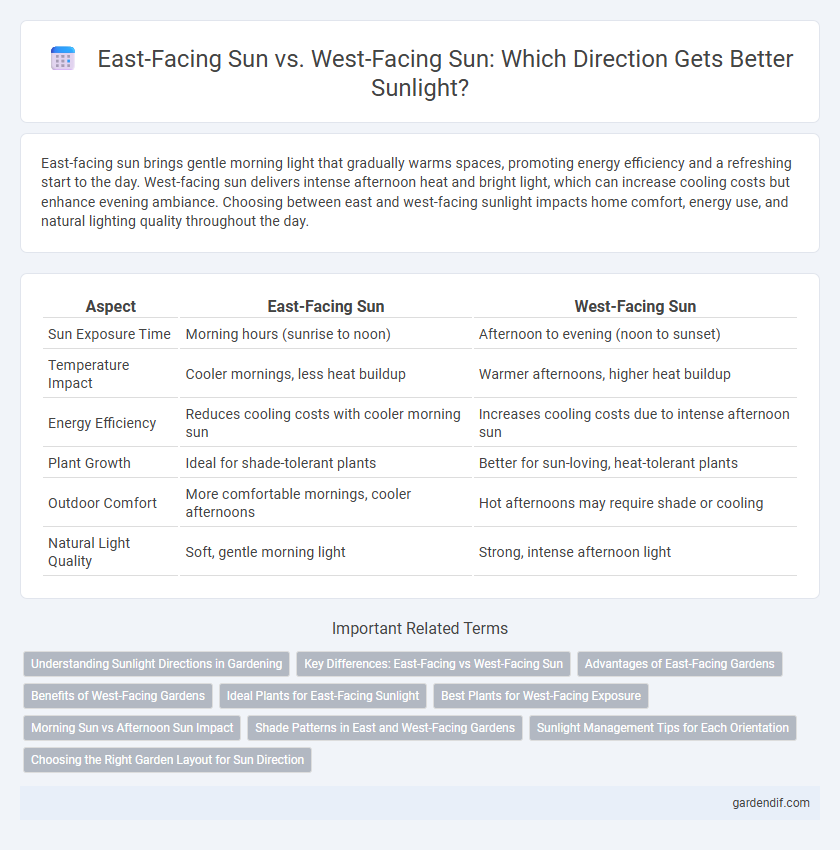
East-Facing Sun vs West-Facing Sun Illustration
East-facing sun brings gentle morning light that gradually warms spaces, promoting energy efficiency and a refreshing start to the day. West-facing sun delivers intense afternoon heat and bright light, which can increase cooling costs but enhance evening ambiance. Choosing between east and west-facing sunlight impacts home comfort, energy use, and natural lighting quality throughout the day.
Table of Comparison
| Aspect | East-Facing Sun | West-Facing Sun |
|---|---|---|
| Sun Exposure Time | Morning hours (sunrise to noon) | Afternoon to evening (noon to sunset) |
| Temperature Impact | Cooler mornings, less heat buildup | Warmer afternoons, higher heat buildup |
| Energy Efficiency | Reduces cooling costs with cooler morning sun | Increases cooling costs due to intense afternoon sun |
| Plant Growth | Ideal for shade-tolerant plants | Better for sun-loving, heat-tolerant plants |
| Outdoor Comfort | More comfortable mornings, cooler afternoons | Hot afternoons may require shade or cooling |
| Natural Light Quality | Soft, gentle morning light | Strong, intense afternoon light |
Understanding Sunlight Directions in Gardening
East-facing sunlight provides cooler morning rays that are ideal for plants requiring gentle light and lower temperatures, supporting early photosynthesis and reducing heat stress. West-facing sunlight delivers warmer, intense afternoon rays that promote vigorous growth in sun-loving species but may increase water demand due to higher evaporation. Understanding these differences helps gardeners optimize plant placement, balancing light intensity and heat exposure for healthier gardens.
Key Differences: East-Facing vs West-Facing Sun
East-facing sun delivers gentle morning light, creating cooler indoor temperatures and reduced glare, ideal for energy-efficient homes. West-facing sun exposes interiors to intense afternoon heat and bright light, increasing cooling costs and potential fading of furniture. Understanding these key differences helps optimize natural lighting and thermal comfort in building design.
Advantages of East-Facing Gardens
East-facing gardens benefit from morning sunlight that is softer and cooler, promoting healthier plant growth and reducing the risk of heat stress. This orientation enhances the development of moisture-loving plants by maintaining higher humidity levels during the early part of the day. Exposure to gentle dawn light also supports energy-efficient gardening by minimizing water evaporation and reducing the need for artificial cooling.
Benefits of West-Facing Gardens
West-facing gardens receive abundant afternoon sunlight, which supports robust plant growth by providing consistent warmth and light during peak solar hours. This exposure enhances the blooming period of many sun-loving plants and increases the yield of vegetables like tomatoes and peppers. The gentle evening light also creates a comfortable outdoor environment for relaxation and social gatherings.
Ideal Plants for East-Facing Sunlight
East-facing sunlight provides gentle morning rays ideal for shade-tolerant plants like ferns, hostas, and impatiens that thrive without harsh afternoon heat. Plants such as begonias, caladiums, and foxgloves flourish under this moderate light, promoting vibrant foliage and steady growth. Choosing east-facing sunlight for planting helps maintain moisture levels and reduces the risk of leaf scorch in delicate species.
Best Plants for West-Facing Exposure
West-facing exposure provides intense afternoon sunlight, ideal for heat-tolerant and drought-resistant plants such as succulents, lavender, and tomatoes. These plants thrive in strong, direct sunlight and benefit from the warmth retained during the day. Optimal growth in west-facing gardens requires selecting species that can withstand higher temperatures and occasional sun stress.
Morning Sun vs Afternoon Sun Impact
East-facing sunlight delivers gentle, cooler morning rays that enhance mood and support plant photosynthesis without overheating interiors, ideal for energy-efficient homes. West-facing sun exposes spaces to intense afternoon heat, increasing cooling demands and causing potential glare issues, which can strain energy resources. Understanding these impacts helps optimize building design for thermal comfort and sustainable energy use during different times of the day.
Shade Patterns in East and West-Facing Gardens
East-facing gardens receive morning sunlight, casting long shadows towards the west that gradually shorten as the sun rises, creating cooler shaded areas during early hours. West-facing gardens are exposed to intense afternoon and evening light, with shadows stretching eastward and providing shade when temperatures peak, which can protect plants from heat stress. Understanding these shade patterns helps optimize plant placement and enhances garden comfort by leveraging natural sunlight cycles.
Sunlight Management Tips for Each Orientation
East-facing windows capture cool, gentle morning sunlight that reduces heat buildup and minimizes glare, making light curtains or blinds effective for soft diffusion. West-facing windows receive intense afternoon sun that causes overheating and fading; installing reflective films or using heavy drapes can mitigate heat and protect interiors. Leveraging landscaping like deciduous trees on the west side enhances shade during peak sun hours, improving energy efficiency and comfort.
Choosing the Right Garden Layout for Sun Direction
East-facing gardens receive gentle morning sunlight ideal for shade-loving plants and early bloomers, promoting healthier growth with less heat stress. West-facing gardens experience intense afternoon sun, requiring drought-tolerant and sun-loving plants to thrive amid higher temperatures. Selecting the proper garden layout aligns plant species with sun exposure, optimizing photosynthesis and conserving water resources.
East-Facing Sun vs West-Facing Sun Infographic

 gardendif.com
gardendif.com